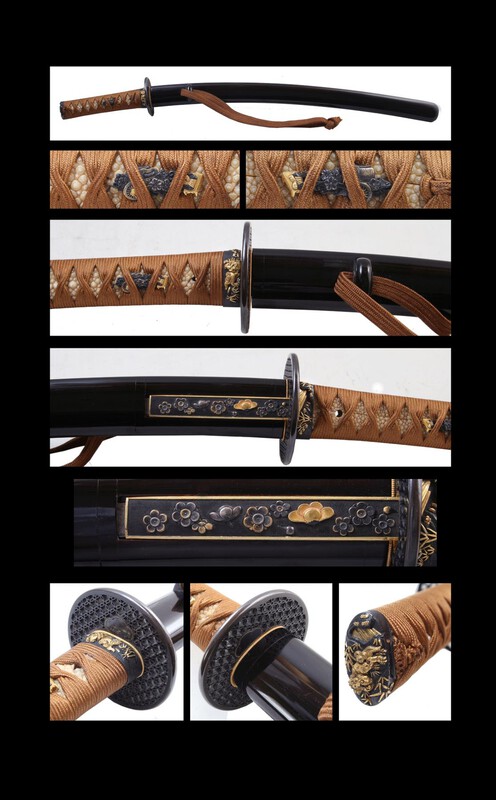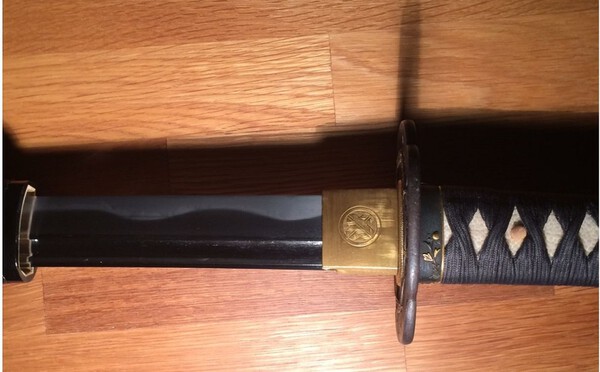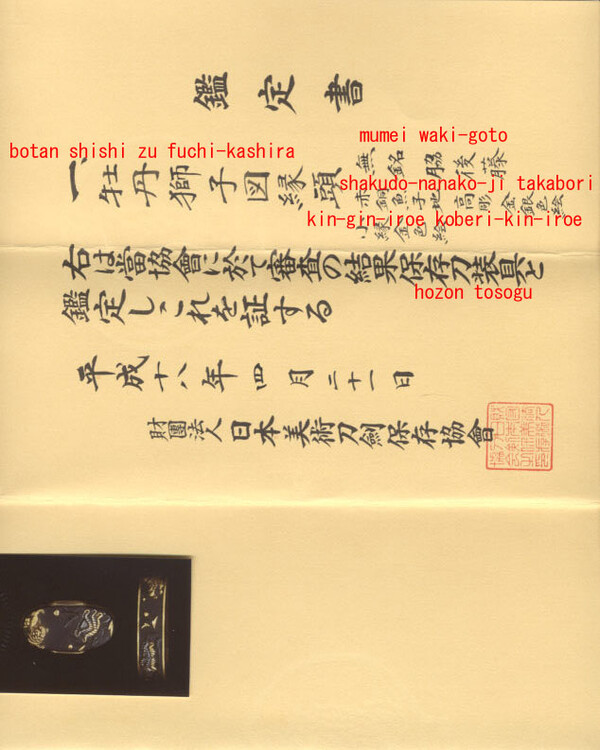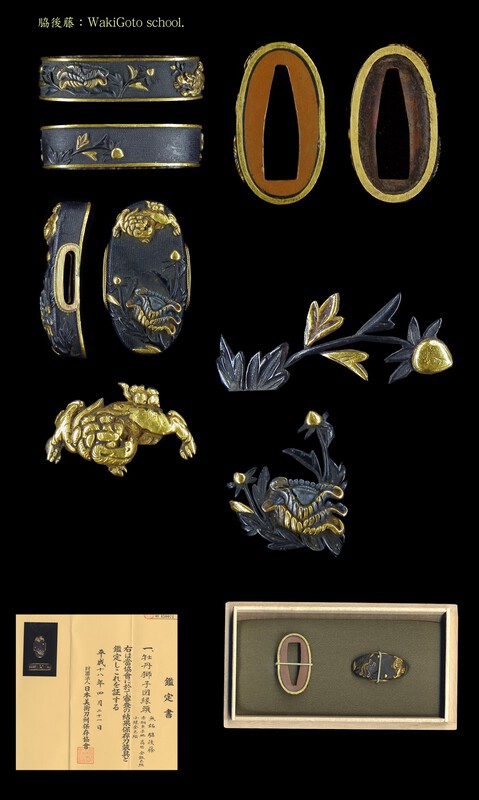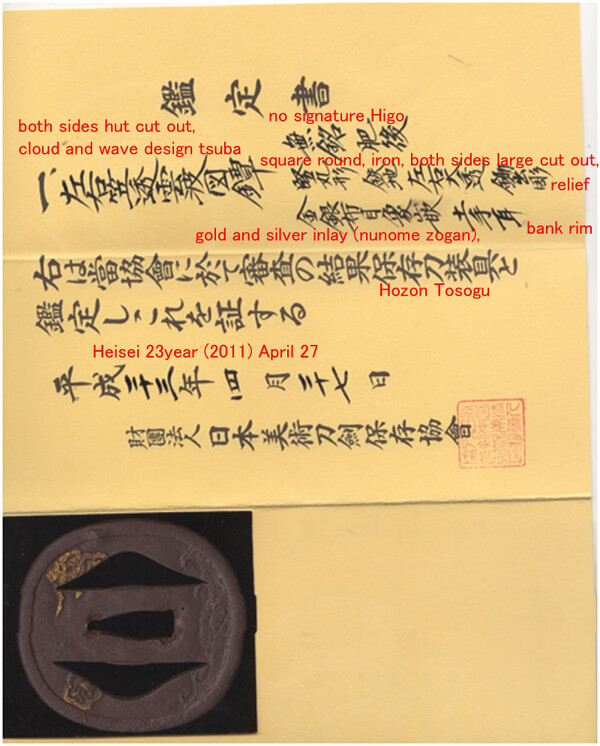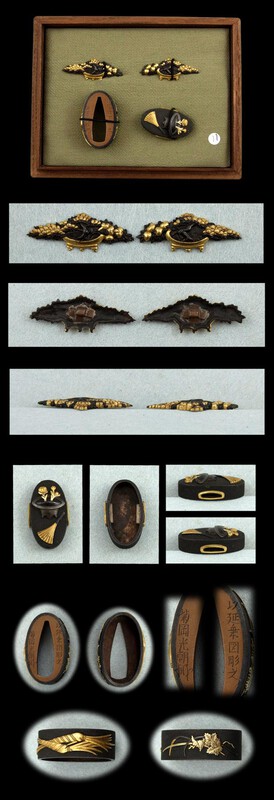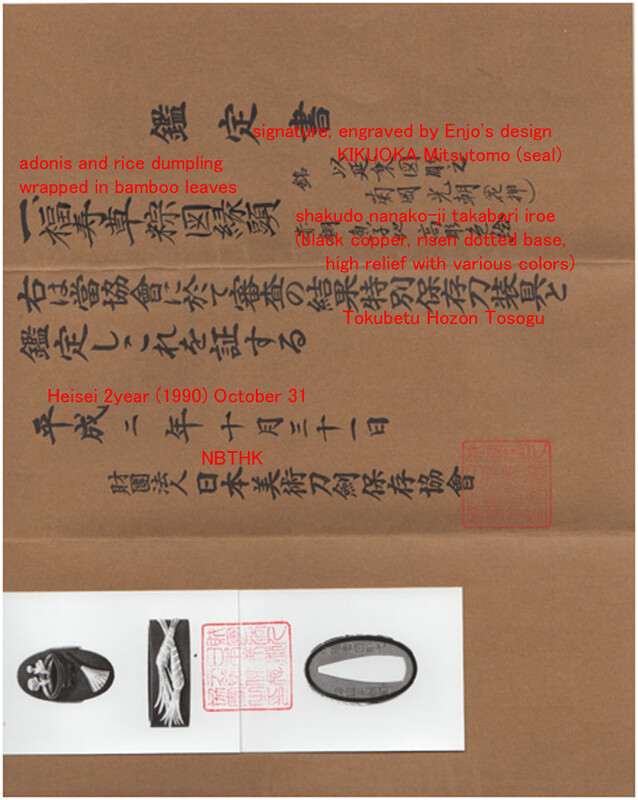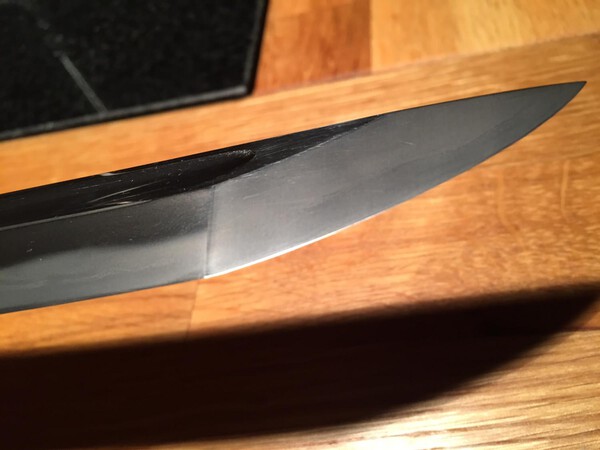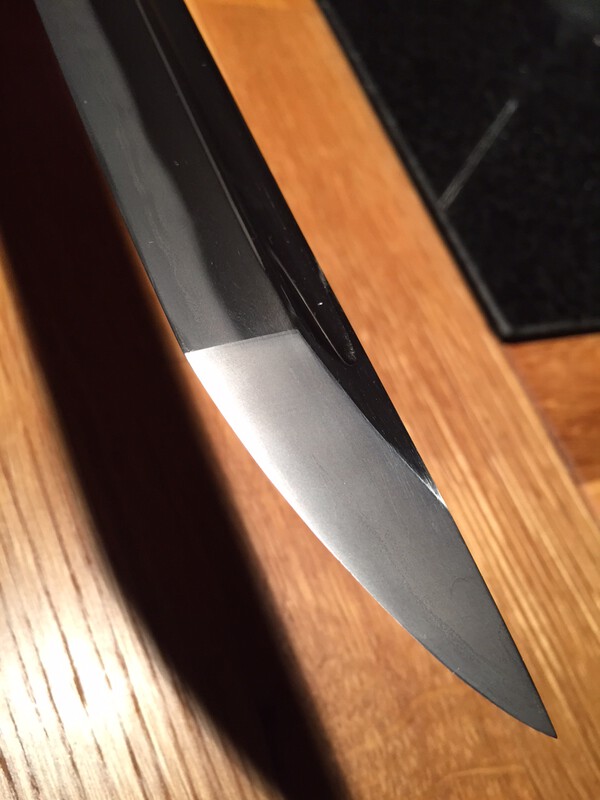-
Posts
61 -
Joined
-
Last visited
Content Type
Profiles
Forums
Events
Store
Downloads
Gallery
Everything posted by Gokaden
-
To quote from Nihontocraft.com: Suishinshi Masahide and the Functionality of Nihonto: http://www.nihontocraft.com/Suishinshi_Masahide.html Of course you can breake the Kissaki if you try to cut stone "19. An Etchigo Takeda retainer hit his katana on a stone lantern in the garden of a Shinto shrine. The kissaki broke off"
-
Did you put it in for the next Juyo shinsa?
-
Admin: This topic is split off of another one where I mentioned fake papers, merely as an aside to prevent us from being accused of ignoring the issue. However, the issue is a minor one, and not one that we should concern ourselves with too much. As mentioned, it happens anywhere in the world where there is a financial stake in something, and we should not allow ourselves to become paranoid. As always, if you know your seller, and your sword, you should be fine. The percentage of false papers out there is minuscule. However, in the interests of transparency and fairness, I am splitting those comments and leave them up here. However I will be locking the topic unless there is good, constructive info to add. What follows, are the posts from the other topic. Can you inform a little about the controversy over papers that you mention? I always believed the H & TH papers to be "safe".
-
Given the rarity of works by Kiyomaro for sale at any point of time, I would expect it to fetch top dollar, but how would you ship such a treasure? Sure not on a container ship and waiting for it to arrive?
-
So payed 50 M Yen back in 1986 or so, now sells for 27 M Yen? Sound investment?
-
Late Edo period fittings for a sword that turned 600 years old in 2015 The sword is still doing quite well!
-
-
-
I am very discouraged to hear this.
-
A set of Fuchi Kashira and Menuki, the Fuchigashira with signature "Kikuoka Mitsutomo Motte Enjyo Zu Horu no" Fuchigashira with NBTHK Tokubetsu Hozon Paper Kikuoka Mitsutomo was born 1776 and passed away 1813. He was the son of Kikuoka Mitsuyuki. Fuchi Kashira On the shakudo nanako plate, Shimenawa and plant are engraved, Fuchi Length : 3.91 cm x 2.47 cm x 1.39 cm (1.53 inches x 0.97 inches x 0.54 inches) Kashira Length : 3.41 cm x 2.06 cm x 1.06 cm (1.34 inches x 0.81 inches x 0.41 inches) On the shakudo nanako plate, Bonsai and Japanese brush are engraved with gold color. —————– Menuki : Length 1 : 4.08 cm x 1.53 cm (1.60 inches x 0.60 inches) Length 2 : 4.20 cm x 1.49 cm (1.65 inches x 0.58 inches) On the shakudo nanako plate, flowers are engraved in the Bonsai bowl. http://imgur.com/IIosSoR
-

Shipping Europe To The Us
Gokaden replied to Lilleskit's topic in General Nihonto Related Discussion
Shipping restrictions is what kills the market for me atm -
-
Would it make any sense to elaborate on the idea that the sword smiths back then more worked like a Guild or a group producing blades? There would be a master of course, and his students making the blades and with the master putting the signature on approved swords. That would explain the variations in the Morikage "sword factory" of the time?
-
Look how good you all did, special mentions go to Jean, Kronos, Markus, Curran, you picked well and deserve atari. I think this was a tough one personally and I am very impressed with the responses. Like I said before, keep up the good work
-
Anyone been able to take a peek at the Phase II of this lovely exhibition yet?
-
And now for the results This sword previously had an attribution to Bizen Kanemitsu. When it was "re-discovered" it was judged by the NBTHK first as Omiya then specified to Bizen Morikage Tanobe Michihiro states on the Saya-gaki: 前国長船盛景 大摺上無銘也 Bizen koku Osafune Morikage, Osuriage Mumei Nari Bizen koku Osafune Morikage, it is a much shortened, now unsigned blade 同工ノ作域ハ廣ク本作ハ最モ変化二富ム山形ノ互乃目乱レ風ヲ示ス ト鑑セラレル Doko no sakuiki ha hiroku honsaku ha mottomo henka ni tomu yamagata no Gunome Midare fuu wo shimesu to kanserareru This sword smith displays various characteristics in his works. Of all his pieces, this particular blade shows one of the most various style of Gunome Midare shaped hamon. 出来宜敷ク制作ハ貞治頃ノ手代ナラン Deki yoroshiku seisaku ha Joji goro no shu dai narann. This sword is well made. The sword was made at Joji period (1362-1368) Explanation of the smith, with information from Shijo Kantei No 620 (September, 2008 issue) This is a golden age Nanbokucho blade. Morikage’s work with signatures which are seen today have early dates from Koan 2 (1362), and later ones from Oei 1(1394), and previously it was thought that this was the same name used by three generations of smiths. However, today there is a strong opinion that there was one sword smith, and he changed his style from time to time. Morikage was active during the Nanbokucho period to the early Muromachi period, and his swords are long with a wide mihaba, and there is not much difference in the width of the blade between the moto and saki. There are O-kissaki tachi, with wide mihaba, and small wakizashi and tanto which have an Enbun and Joji style shape. Around the Eiwa (1375-79) era which is after the golden age of the Nanbokucho era, Morikage’s tachi shapes become a little narrower, and the difference in the width between the moto and saki is smaller, and the kissaki is a little smaller, and typical Eiwa era shapes can be seen. At the end of the Nanboukcho period, his swords changed to have an average mihaba, and there is a difference in the width between the saki and moto areas; the kissaki are chu-kissaki; and the swords are koshisori; the tip has sori which is seen on kosori school type swords. Morikage is not a mainstream Nanbokucho Bizen sword smith, and his jitetsu show a strong itame hada mixed here and there with there with o-hada; they have different colored jifu, and the utsuri is pale or faint. Morikage made all kinds of swords, and this sword’s hamon is predominantly a Kanemitsu style hamon (but his midare hamon are not as smooth as Kanemitsu’s hamon and show a more square appearing pattern). Morikage has few swords from the end of the Nanbokucho period, and typically, from this time swords show shallow ko-notare and ko-gunome mixed with ko-togariba, and the entire hamon appears small or narrow, as is seen on kozori swords. Most of Morikage’s swords have ashi and yo, and the nioiguchi is toned down and has mura nie. Morikage’s boshi are mostly midare-komi, and with a sharp tip. Swords with suguha hamon have straight boshi with a komaru. Not being a mainstream Bizen smith, his work sometimes show rustic ji and ha, and this is also characteristic of Morikage swords in his various styles. His horimono include bo-hi, soe-hi, futasuji-hi, bonji, sankoken, haramiryu style kurikara, and Hachiman-daibosatsu kanji. Morikage’s nakago are kurijiri, and his yasurime are kattesagari. Like before mentioned, people thought the sword smiths who signed Bizen Osafune Morikage were from the Omiya school, and were a father and son Kunimori, and Sukemori, who used live in Yamashiro-kuni Ikumadaigu and then moved to Bizen, and Osafune Morikage was a later generation descended from these two. However, recent opinions are that the Omiya school who came from Yamashiro-kuni, who was called Omiya Morikage and Osafune Morikage were different persons, and that Osafune Morikage was one of the famous Osafune smiths who followed Chikakage, and he belonged to the same school as Yoshishige, and Mitsukage. My personal thoughts: I think the Kissaki must have been reshaped, maybe even twice, thus the lack of Kaeri, the obverse side shows a good Kanemitsu-style boshi (I will try and take a picture of that later) I would not disagree with an attribution to Bizen Kanenaga since the blade without a doubt is a Soden-Bizen product, or his master/teacher Chogi (Nagayoshi), who is another Bizen smith (and peer of Kanemitsu) who is among the Juttetsu and has the reputation of the "least Bizen-like Bizen smith". I would also consider Tanshu Kunimitsu, and students of the Sa-school. Aoi-Art has a Den-Kanenaga that I think share some common traits as well: http://www.aoijapan.com/katana-mumei-den-kanenaga17th-nbthk-juyo-paper Finally, Tsuruta-San also has a signed Morikage for sale: http://www.aoijapan.com/tanto-bishu-osafune-morikage
-
I will publish the sword smith on Saturday, September 12. Keep up the good work
-
This is another one from my collection. It is one of my favourite swords. Ha-watare : 72.4 cm or 28.50 inches. Sori : 1.1 cm or 0.43 inches. Width at the hamachi : 3.01 cm or 1.18 inches. Width at the Kissaki : 2.31 cm or 0.9 inches. Kasane : 0.75 cm or 0.29 inches. Shinogi-tsukuri, Ihori-mune, strong sword and feels heavy in hand, little curve and O-kissaki. Bo-hi runs through the whole nakago with soe-hi ending at the bottom Mekugi-ana Hada is a mix of Mokume/itame, ji-nie can be seen and there are defined chikei. Midare Utsuri becomes strong near the base of the blade. Hamon is a variated Gunome- and Choji- midare of Ko-Nie and Nioi-Fukashi. Midare-Komi and Sunagashi Boshi with a slightly insulated area of unhardened steel. Slight Kaeri. O-Suriage Nakago has two Mekugi-ana.
-
Thank you Bugyotsuji, great information!
-
Supereme Sword Country,Bizen First stage(Tuesday, June 9 - Sunday, August 25, 2015) Second stage(Tuesday, August 25 - Sunday, November 1, 2015) In the area currently known as the Okayama Prefecture, a Supreme Sword Country, Bizen, once existed, prevailing from the Heian until the Muromachi period. The history of sword country Bizen can be traced back to a group of swordsmiths known as Ko-Bizen-mono in the latter half of the Heian period. With the two great swordsmiths, Tomonari and Masatsune, a number of swordsmiths established a firm foothold of the sword country. The Ichimonji school succeeded sword making. Conforming with the distinctive culture of the military samurai government that was in power during the Kamakura period, they created swords of dignified shapes with splendid choji hamon, thereby launching the flourishing age of sword production. Recognizing Mitsutada as its de facto founder, the Osafune school continued by his legitimate successors, Nagamitsu, Kagemitsu, and Kanemitsu. They formed the greatest lineage in Japanese sword history, which lasted until the Muromachi period, and consequently ensured the solidity of the “Supreme Sword Country, Bizen.” This exhibition follows in the footsteps of the Bizen swords by featuring works from the legitimate Osafune line, along with great works by members of collateral lines, Nagayoshi and Motoshige, from a time of social upheavals in the Nanbokucho period. Concurrently, there is also a focus on a group of swordsmiths known as Kozori-mono. Overall, this exhibition presents the attractiveness of the Bizen swords of the sword country. It would be greatly appreciated if you would take this opportunity to step into the world of the “Supreme Sword Country, Bizen.” http://www.touken.or.jp/english/index.html
-
Getting the Nengo and the school correct usually gives "Dozen", but I give you an Atari 2600
-
No irony att all, only steel and iron
-
What a fine blade. I too, had hoped for a Muramasa judgement, at least I have symmetrical hamon on both sides of the blade...
-
Here are the papers issued and I agree to the NBTHK judgement as Ganmaku school work. It is a well balanced blade in the hand, a sword you would trust to carry in times when your life could depend on it. Its not a masterpiece, and it has a few areas of rough steel. It has a feeling of sharpness to it. The steel color is that of a Mino sword, perhaps not so visible in the photos. Other references: http://sanmei.com/contents/media/A58742_W8251_PUP_E.html http://sanmei.com/Pictures/Sword/k_A58742_W8251.jpg http://www.kanshoan.com/english/swords/h27_nobusada.html http://www.sanmei.com/contents/en-us/p1883.html http://www.sword-auction.jp/auction.cgi?acc=disp&no=1430441826&t=1213703271 The Connoiseurs Book of Japanese Swords (Nagayama) p. 222, Leading smiths of the Mino Tradition
-
Comes from my collection, how would you kantei this one? Blade data: Nagasa 74.84 cm or 29.46 inches Sori 1.4 cm or 0.55 inches Motohaba 2.88 cm or 1.13 inches Sakihaba 2.01 cm or 0.79 inches Kasane 0.6 cm or 0.23 inches


